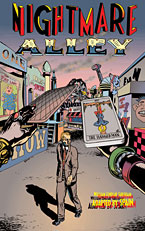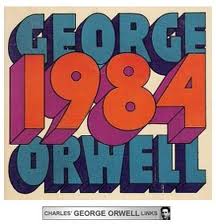How is your day going? What have you been up to?
I’m coming to the end of the hiatus I took from my novel, The Tome of Worlds. I begin the editing process Sunday morning, 8/18.
In the interim I have written a short story on the death of Edgar Allan Poe called “Reynolds! Reynolds!”, a short story centered around a door to another time and place called “The Door Frame from Yesteryear”, and I have conceived of another story–short or novel I do not know yet–of the life a handicapped man as a freak in a 1930s Carnival.
The last story requires research because the extent of my knowledge of depression-era carnivals comes from the cancelled HBO television series Carnivale, so I will soon begin reading a novel called Nightmare Alley by William Gresham, the story of a man’s downward spiral to the level of a geek in a 1930s carnival, the lowest of the low in carnival life. Has anyone read Nightmare Alley?
I don’t know where the story of the handicapped man will take me, but it’s a story I must tell.
But, on to editing. As with the last post, much of this advice comes from the editing novel The Fire in Fiction by Donald Maass.
In my last post on editing I covered the following topics:
Summary for Editing Post I
- Always, always, always write with passion.
- Live through your characters. Feel what they feel. Use your own experiences to convey those emotions.
- Show villainy, loathing, and greatness through impact on the world and characters
For this post I will talk about villains.
Villains
Who are the memorable villains?
- For me Voldemort was not memorable as a villain. I sympathized with him, but he was not memorable in the same way as Harry, Ron and Hermione.
- The Kingkiller Chronicles by Patrick Rothfuss has a villain, but the villain is not memorable; rather, the villain is fleeting and ambiguous. He lurks.
- The White Witch from The Chronicles of Narnia? Still, no. She lures in and tricks Edward, is evil to children, but she is pure, black and white evil.
- O’Brien from 1984. Now there was a villain. He lured in the protagonist and betrayed him. O’Brien’s memorable quote was “One does not establish a dictatorship in order to safeguard a revolution; one makes the revolution in order to establish the dictatorship.”
- Mustapha Mond from Brave New World. He wasn’t a villain, but he believed that they had to sacrifice certain freedoms for the good of society. His arguments were compelling.
- Moby Dick? A symbol of obsession? Or just a whale?
- Sauron was straight evil. He was a villain, yes, but he had no depth. Personally I found Saruman to be a greater evil because he was once good.
Depth. Great villains require depth. They cannot be a cardboard Mr. Evil. I must understand their motivation, which is why most of these villains fail for me.
Voldemort was evil, but why did he want to convert the world into a magical version of 1984? Just because he thought wizards were better than muggles? I saw a mix of Hitler and 1984 in Voldemort, but there was very little depth to Voldemort, little justification for why he became who he became.
Out of the villains I list, O’Brien is my favorite. He lures Winston Smith into a trap posing as a member of The Brotherhood, an ambiguous revolutionary group Winston seeks to join. O’Brien appears, at first, to be friendly and sympathetic to Winston’s dislike of the party. He becomes Winston’s friend. In the end it is O’Brien who turns on Winston, tortures him, re-trains him.
O’Brien is evil. He believes he is right. Like Mustapha Mond he makes compelling arguments. During O’Brien’s initial interactions with Winston, O’Brien comes across as human.
Now, I have not read 1984 in twenty years, but I still remember O’Brien. When I set out to write this post I was not thinking about 1984, but when I had to think about villains, O’Brien came to mind instantly.
So what makes a great villain in your mind?
Donald Maass says that there is no villain as scary as one who is right. I believe that’s why I found O’Brien to be such a deep villain. I didn’t agree with O’Brien’s philosophy, but in the end Winston did. If you, as a reader, believe in the protagonist, as I believed in Winston, as I came to be committed to Winston, then when the protagonist is swayed by the villain you are moved, too.
There are three villains in The Tome of Worlds:
- Naestrum, the master of a realm called The Deadlands, a place people go when they become lost
- The Seers, a group of creatures from another land who are believed to be all-knowing, all-seeing
- Tartarus, the embodiment of Hell from Greek Mythology
When I re-visit my novel I intend to put more into these villains. Donald Maass suggests you do the following, and I agree:
- Justify your villain’s actions
- Make them right
- Write a villain who could sway you
- Reject the idea of evil. Make the villain good (from their point of view)
- Don’t let the villain lurk, put them in your protagonist’s face
Once again I notice a theme in this advice. If you want the reader to believe in your villain, make your protagonist believe in him.
Editing Post III
For the next installment I will hit upon secondary characters and sidekicks, though the advice is similar to what I just presented for villains. The bulk of the post will focus on scene revision.
As always, if you have any editing advice please don’t hesitate to add your opinion. Thank you.


